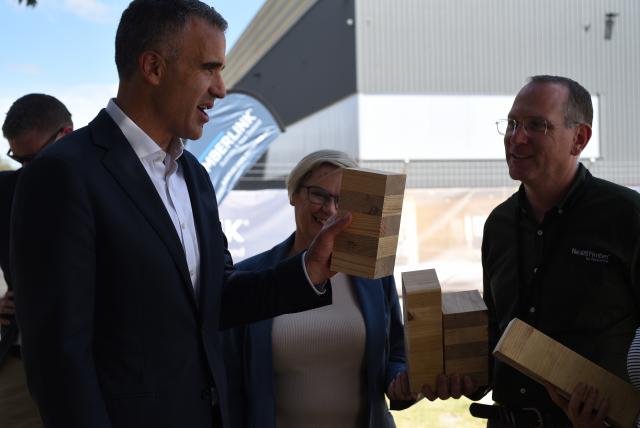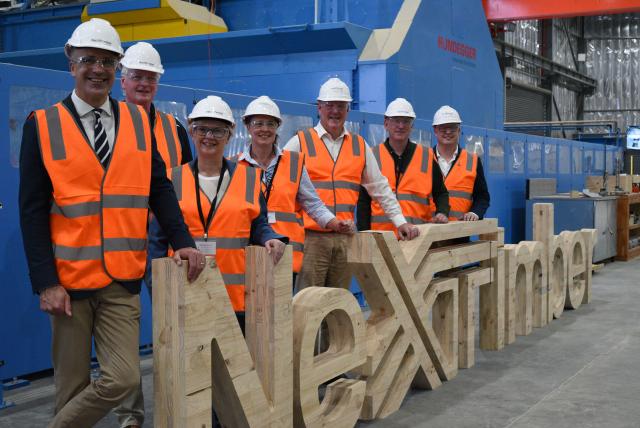
Charlotte Varcoe
A WORLD-CLASS timber facility was officially opened last week with more than 300 employees, stakeholders and distinguished guests gathering at Tarpeena’s Timberlink mill.
Timberlink’s $70m NeXTimber facility was officially opened by Premier Peter Malinauskas.
The facility is the nation’s only cross-laminated and glue-laminated timber radiata pine mass timber facility and the first in Australia to be integrated with a structural timber manufacturing plant.
NeXTimber is able to produce cross-laminated timber panels up to 16-metres long and three-and-a-half metres wide.
The glue-laminated timber beams are able to be made up to 12-metres long and can provide an alternative to traditional construction materials while also helping reduce the embodied carbon of a project.
These timber structures can also be built up to 12 stories or more if combined with other materials in a hybrid timber construction.
Ground was broken on the expansion in 2022 and construction on the site continued until late 2023.
The facility has been taking orders since November 2023 and has created more than 30 full time positions.
Timberlink chief sales, marketing and corporate affairs officer David Oliver said the opening was a fantastic event with visitors from all over the nation and New Zealand.
“We are going to deliver building skyscrapers from this facility,” Mr Oliver said.
“This replaces concrete walls for stairs and roofs and glue-laminated timber beams replace steel in columns and beams.”
He said after working alongside the facility’s chief executive for almost six years on the project it was “really exciting” to finally cut the ribbon and officially open the mill.
“The thing I am really excited about is the level of engagement from industry,” Mr Oliver said.
“We have had consulting engineers, architects and builders who have come from around the country and invested time to come and see the facility which is really exciting.
“What this means for the business and the region is the timber industry has historically been highly dependent on residential housing builds.”
He said if there was a decline in residential housing it generally meant less timber was produced and less economic activity.
“The benefit of cross-laminated and glue-laminated timber is we can provide timber from the region from the Green Triangle which had never been used in high rise buildings before,” Mr Oliver said.
“There has been lots of international interest with one of our customers from the Kingdom of Saudi Arabia visiting in two weeks time with a trillion-dollar project they are involved in and they are looking to build in a more sustainable way.”
He said there was also great interest from other areas in South Australia, New South Wales, Queensland and New Zealand.
Minister for Forestry Clare Scriven labelled the facility as “really impressive” and said it was a “great asset” for the community, region and state.
“This is showing how advanced manufacturing continues to develop within the forestry industry which is so important to our region,” Ms Scriven said.
“It is creating advanced manufacturing jobs which can only be good and one of the things this demonstrates is the opportunities for decarbonisation by using forest-based products.
“It means we have got opportunities in terms of increased use of the renewable timber-based products which are so important for decarbonisation in our built environment.”
Ms Scriven said the facility showed there were “real opportunities” for further development through diversification of products through the value adding and evaluating.
Mr Malinauskas said the facility “ticks every box” with it being a demonstration not just to the local industry but also the state where there were opportunities and decarbonisation.
He said there may have also been discussion as to whether the facility could produce products for the future build of public houses.
“I think the government has a responsibility to show leadership in the market where we believe there are products being produced locally which deliver an outcome for our economy,” Mr Malinauskas said.
“Cross-laminated and glue-laminated timber is a good example of protecting local fiber and using local labour to value add to it into a high quality product which could be a replacement for structural steel.
“We do see an opportunity there and that is something we want to work on.”








